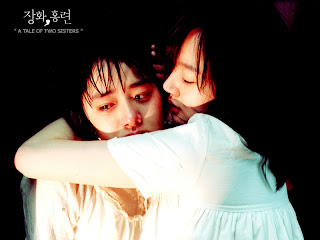* * * * *
(Dir. Kim Ji-Woon, 2003)
When does a person die?
What is most disturbing about Kim Ji-Woon's masterwork is surely the Freudian question, recently put by Nicholas Royle at the Brighton book launch for his debut novel Quilt. Quilt is the venerable academic's take on the death of a parent: a trampoline of words and symbols springs its narrator into a new height of breathing. Here, 'past' and 'present' lose significance. Here, humid illusion threatens to prevail. In A Tale of Two Sisters, a step-daughter struggles in this same air. There are the old devices of horror at work - the dead and the sick demanding attention via a seething piano. This time, the smallness of beauty preceding the climaxes is not played out in some pseudo White House in the Hamptons. On a film set in rural South Korea, audio-visual horror finds a cultural serenity all the more frightening to upset.
What is most disturbing about Kim Ji-Woon's masterwork is surely the Freudian question, recently put by Nicholas Royle at the Brighton book launch for his debut novel Quilt. Quilt is the venerable academic's take on the death of a parent: a trampoline of words and symbols springs its narrator into a new height of breathing. Here, 'past' and 'present' lose significance. Here, humid illusion threatens to prevail. In A Tale of Two Sisters, a step-daughter struggles in this same air. There are the old devices of horror at work - the dead and the sick demanding attention via a seething piano. This time, the smallness of beauty preceding the climaxes is not played out in some pseudo White House in the Hamptons. On a film set in rural South Korea, audio-visual horror finds a cultural serenity all the more frightening to upset.
We begin at the psychiatrist’s table. The protagonist, Su-mi, is non-responsive and phantom-like. She is living in the past to carry on another person's life - that of her sister. Her malady - we realise later that this is severe dissociative identity disorder - is of casual concern compared with what she has lost. If we have figured it out in the first ten minutes, this doesn't spoil the movie. From the talkative psychiatrist and the catatonic Su-mi, we spring to an overhead shot of Su-mi and her little sister, lying above a lake, their shoes removed in pairs. As soon as we learn the sisters' mother has died, the tale begins and belongs to Su-Mi. Everything takes place in the house they are growing up within. Everything emotional is sincere, though nothing in the plot is remotely trustworthy.
The genre chosen is apposite. A Tale of Two Sisters is, among other things, about the limp, delicate role of women who are utterly domesticated. Su-mi smashes the idea of role playing, bent on protecting her sister from terror. The step-mother is constantly made-up and washing or preparing food, the pitiable father intellectually rejects his feminine household, the screenplay is notebook-thin and yet silence in this film can not be underdescribed as lingering.
Inspired by a myth originating in Korea, or what used to be Josean Dynasty, A Tale of Two Sisters was in 2003 the sixth attempt by film makers to do justice to this sinister folktale. It is so far the most successful; standing as the highest grossing film in the history of South Korean cinema, it won at the 2004 International Fantasy Film Awards but was snubbed, typically, by the Academy (last year it were Michael Haneke and Jacques Audiard's turns at empty-handed genius, for The White Ribbon and A Prophet respectively).
Kim Kap-su and Im Soo Jung were cast as father and daughter, and the actors fulfilled their contracts as if resolving some real life trauma. Yeom Jong-Ahn, as the step-mother, did a kind of Clytemnestra terribly well. As psychological thrillers and horrors go, this is cruelly honest: it goes down as the scariest I have encountered. For better or worse in our dreams, A Tale of Two Sisters is a resident desire.

No comments:
Post a Comment